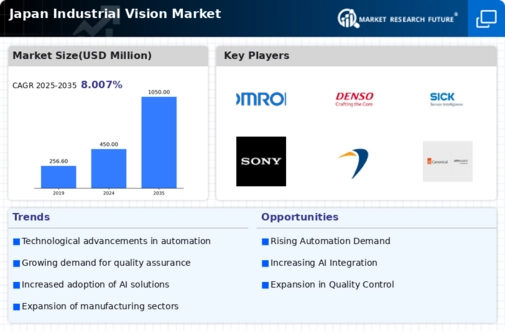The Japan Industrial Vision Market is characterized by rapid technological advancements and a highly competitive landscape. This market encompasses various applications such as quality control, automation, safety monitoring, and robotic guidance systems, driven by the growing demand for efficiency and accuracy in manufacturing processes across multiple industries. Key players in this market are racing to innovate and enhance their product offerings, leveraging advanced technologies like artificial intelligence, machine learning, and image processing capabilities.
The competitive environment is marked by significant investments in research and development to meet evolving customer expectations and industry standards, while also expanding their market reach both nationally and globally.
The presence of stringent regulatory policies in Japan further emphasizes the necessity for companies to adapt and innovate in order to thrive.Omron has established itself as a leading player in the Japan Industrial Vision Market by focusing on high-quality automation and sensing solutions. The company's commitment to innovation is evident through its ongoing investment in research and development to enhance vision system technology, which provides a strong competitive advantage. Omron's extensive product portfolio includes vision sensors, image processing systems, and robot vision technologies designed for various industrial applications, which collectively contribute to improving manufacturing efficiency and accuracy.
The company's reputation for reliability and performance has fostered strong relationships with clients in multiple sectors, enabling a robust market presence in Japan.
Furthermore, Omron's emphasis on customer support and service reinforces its position as a trusted partner in navigating the complexities of industrial automation, thus solidifying its competitive edge.Denso operates as a formidable competitor in the Japan Industrial Vision Market, offering an extensive range of vision-based systems tailored for the automotive and manufacturing sectors. The company excels in developing cutting-edge technologies such as advanced driver-assistance systems and automated assembly line vision systems powered by artificial intelligence. Denso's strategic market presence is bolstered by partnerships and collaborations with various industry stakeholders, facilitating innovation and accelerated development of integrated vision solutions.
The company has made notable strides in mergers and acquisitions, which have expanded its product offerings and market reach while enhancing its capabilities in image recognition and processing. Denso's dedication to continuous improvement and sustainability in its operations has contributed significantly to its reputation, allowing it to maintain a competitive position within the dynamic industrial vision market landscape in Japan.





















Leave a Comment